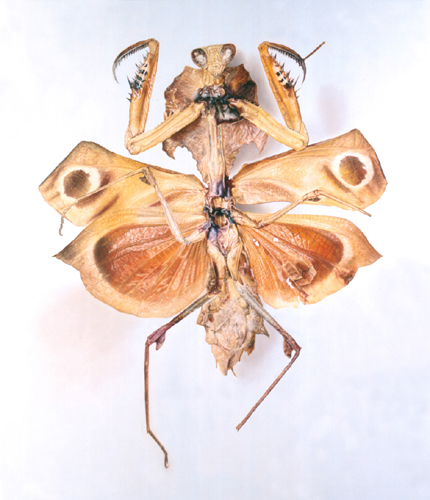
Specimen (4)
Oil on canvas
215 x 183 cm
2000
© Mark Fairnington
|
Review of the “Fabulous Beasts” Exhibition, Jerwood Gallery, by Christina Brodie, UK |
| Original artwork is © Mark Fairnington and Giles Revell and the images enclosed must not be used or distributed without their permission. All rights reserved. Photographs of artwork are presented with thanks to, and permission of, the
artists and the Natural History Museum. |
The depiction of microscopic objects in art has long been considered as a fascinating “fringe interest” or sub-genre to many. However, this well-publicized current exhibition at the Natural History Museum, which brings together the talents of painter Mark Fairnington and photographer Giles Revell, and which features large-scale, beautifully realistic images of insects, reflects a reintroduction of this type of work into mainstream culture, along with the rebirth of an interest in microscopic images.
Micro-organisms and microscopic viewpoints have from time to time been drawn on by visual artists for inspiration, usually because of their surreal appearance and/or to illustrate an artist's concept. In this instance, the method of representation may tend towards abbreviation or adaptation of the organism's form, and the organism may in the process become divorced from its scientific context.
Here, however, the technical skill of both artists, who worked in conjunction with the Natural History Museum's Department of Entomology, and photographic unit, combines their own very distinctive styles of artistic interpretation with brilliant reproduction of biological detail. The subject-matter and its presentation was of particular interest to me since, in presenting the insects as specimens, without sparing richness of colour or lushness of detail, it was strongly reminiscent of 19th-century illustrations of microscopic organisms. Modern scientific illustrations generally lean more towards a functional purpose than an artistic one, so the work here represents a crossover between the disciplines of illustration and fine art.
Mark Fairnington
Mark Fairnington infuses his super-realistic pictures with a painterly style and associations; using a Wild stereo binocular microscope fitted with a Wild Microphot MP5 05 photomicrography attachment and fibre optic illumination, he makes a photographic record of insects from entomological collections. The photographs are then reinterpreted using oil paints on eight-foot-high canvases, which strike one immediately from a distance. However, a view from several inches away proves to be equally fascinating, resembling a miniature galaxy with nebulae of vibrant, contrasting colours crossed by comet-trails of solid colour, that, from an increasingly distant viewpoint, once more resolve themselves into an image.
The sheer intensity of the iridescent colours in some of the insects is mirrored in soft, diffused shadows of the same hues, which imbue the paintings with an energising glow and luminosity that perhaps isn't discernible from the images shown here. Very rarely are the backgrounds pure white; rather, they are variations on white, or more akin to pastel colours. Mark's more recent work shows use of gold leaf as a background, and several insects portrayed against a black background, which I found particularly striking. This departure from the white ground was actually the result of the collaboration with photographers at the Natural History Museum, who use a black background as a convention in insect photography; Mark was interested in this as a convention, so incorporated it into his own work.

Specimen (4)
Oil on canvas
215 x 183 cm
2000
© Mark Fairnington
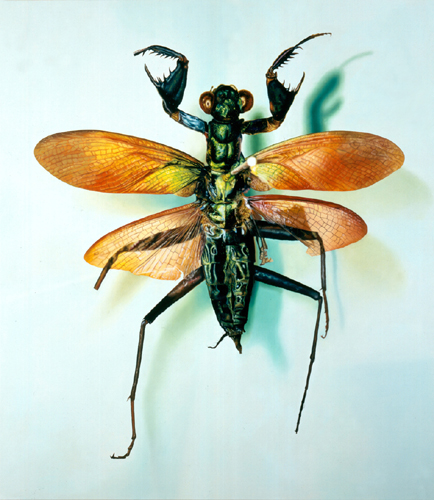
Specimen
(7)
Oil on canvas
214 x 189 cm
2000
© Mark Fairnington
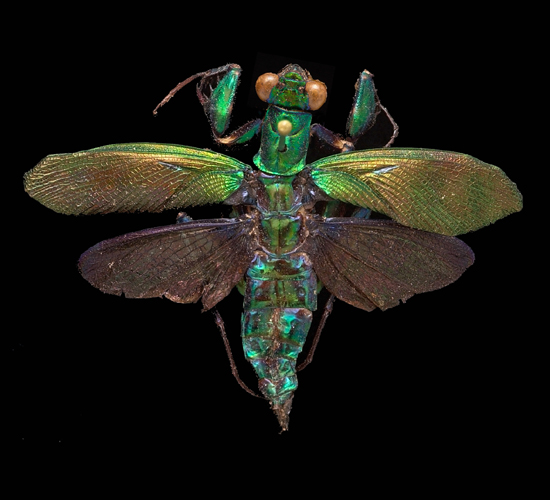
Specimen
(13)
Work in progress
© Mark Fairnington
Prior to the “Fabulous Beasts” exhibition, Mark Fairnington was also involved in the “Mantidae” and “Membracidae” research projects, which required a similar focus on the physical features of insects and the way in which these related to their behaviour and ecology. I was fortunate to be able to question Mark about his work.
CB: Your artwork draws strongly on images from the natural world - how does your current work relate to your earlier work, and what prompted your interest in the natural world as a theme for your paintings? How did you become involved in the “Mantidae” and “Membracidae” research projects?
MF: Earlier work explored different languages of representation and in particular the relationship between painting and photography. I was teaching at The Ruskin School of Drawing and Fine Art, which is part of Oxford University, when I made contact with the entomologist Dr. George McGavin at the Oxford Museum of Natural History. I began to photograph specimens from the Hope Collection under a microscope, as source images for the paintings - this generated the amount of surface detail that enabled me to greatly increase the size of the paintings.
I focused upon the Mantidae because this insect was important to the Surrealists. They saw it as a living automaton, which continues to live after the head has been removed. It was the idea of the “specimen” which became the main focus of the work. Most of those photographed date back to collections from the early 19th century. Once caught, they were pinned to a display board and labelled, placed in drawers and housed in the vast collection. Over the years the bodies dry out and lose their natural colour. They become extremely fragile and, inevitably, some of them get damaged. They describe the complex detail of the specimens as they are now, including the damage that has resulted from the collecting process. Each insect was moved around under the microscope and with each new shot the lighting conditions, colours, shadows and point of focus shifted. These differences became an integral part of the painted image.
Membracidae was a Wellcome Trust funded sciart project looking at the mimetic camouflage of treehoppers. Mimesis has long been established as the basis for Western concern with illusion in art. Mimesis also exists within the natural world where its primary function is to conceal, camouflage or deceive predators, thereby ensuring the survival of the species. The overall purpose of the project was to study the treehoppers' use of mimesis from these two viewpoints. Adult treehoppers often have a large and sometimes weirdly-shaped pronotum which extends backwards and sideways to cover the abdomen and sometimes the whole bug. In tropical species, these unique pronotal extensions can assume incredible branched or inflated forms. |
Collections from the Natural History Museum also provided the inspiration for a series of views of mammalian eyes, painted in oils on wood. The circular shape of the paintings, and the fine detail within them, creates a fun, captivating impression of a “view through a microscopic lens” and further underlines the exhibition's theme of fine-focussing.
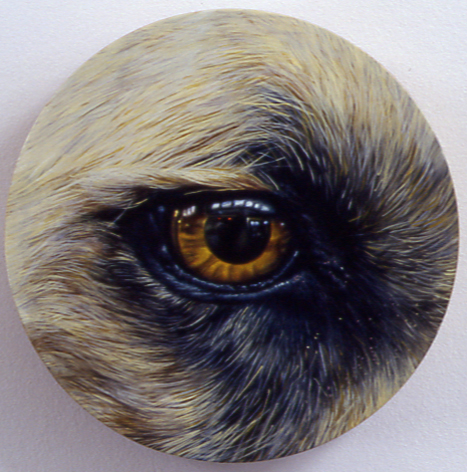
Cape
Hunting Dog
Oil on birch
15.5 cm diameter
2003
© Mark Fairnington
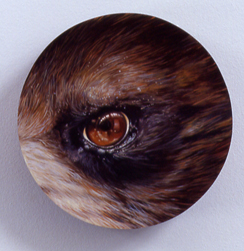
Sloth
Bear
Oil on walnut
13 cm diameter
2003
© Mark Fairnington
“The Ancestors” showcases birds of prey from the Walter Rothschild Zoological Museum, Tring, whereas “The Hummingbird Tree” was inspired by a case from the Natural History Museum. The sheer scale, brilliant and mainly monochromatic background, and complexity of the painting was to me also highly reminiscent of 19th-century art:

The
Hummingbird Tree
Oil on canvas
214 x 300 cm
2003
© Mark Fairnington
CB: Paintings like “The Ancestors” and “The Hummingbird Tree” remind one of the type of complexity found in pre-20th century and especially Victorian art. Do you consider that, in the fine art sector, there has been a shift in recent years away from the 20th-century modernist stance, back to the type of art that is concerned with recording nature in minute detail? Or is this just because artists that do this type of work are illustrators as opposed to fine artists, or haven't been featured prominently? Did you consciously draw inspiration from Victorian art?
MF: 20th-century modernism was fuelled by the idea of vanguard movements which always looked forward. With the collapse of the modernist enterprise in the 1970s art production began to fracture and diversify in many different ways. The persistence of realism as an issue and subject in art is one of the things that interests me in particular. One of its manifestations is a focus upon obsessive detail, in painting, photography and film/video and there are a number of artists, using different media, whose work deals with how we image the natural world. My interest in Victorian and pre-Victorian representations of the natural world is specifically the way in which they fuse fact, fiction and fantasy - the Hummingbird Tree is a spectacular example. |
Mark's realistic painting style draws inspiration from the paintings of Albrecht Dürer, a personal favourite of mine. He is also influenced by botanical/entomological painters Maria Sybilla Merian, whose 17th-century expeditions into the South American jungle yielded an oeuvre of paintings of botanical subjects pictured alongside their insect pollinators, and Ferdinand Bauer; active during the first half of the 19th century and principal natural history artist on the Investigator voyage to Australia from 1801-1803.
Mark's work is represented in several international collections including those of British Airways, Morgan Stanley, the Arts Council/Hayward Gallery and the Saatchi Collection. He currently holds the post of Senior Lecturer in Painting at Wimbledon School of Art.
|
“ - I am interested in the way that scientific research produces a vast quantity of images all the time - representations of the world and our knowledge of it.” Mark Fairnington |
Giles Revell
Giles Revell uses scanning electron microscopes and digital technology to produce stunning, monochromatic eight-foot-high photographs of insects with an incredible level of detail, depth of field and sculptural feel. This is achieved by making up to five hundred high-resolution scans of sections of the insect, merging and enhancing them to create works that infuse the photographic elements of the images with a “hand-finished” touch.
Although the prints are produced using inkjet printers and handwoven archival paper, smoother surfaces, such as those of a damselfly's wing, remind one of subtly graded pencil shading when viewed close-up, with highlights appearing to be defined with the lightest touch of an engraving tool. A bluebottle, when closely examined, reveals itself to be covered in millions of tiny hairs. Each of these appears to have been enhanced, along with each facet of the compound eye! The process of scanning, which takes approximately twenty minutes, is considerably rapid in contrast with the image editing and enhancing, which may require up to several months to complete.
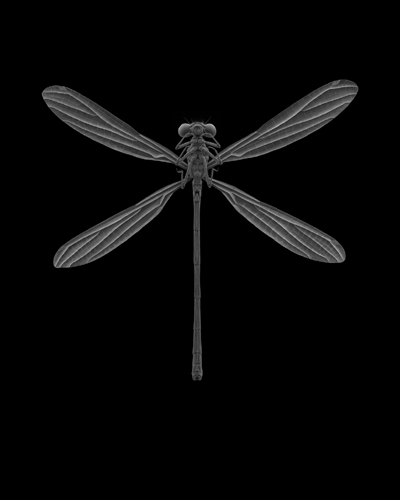
Damselfly
Paper
183
x 146 cm
2001
© Giles Revell courtesy of Michael Hoppen Gallery, London
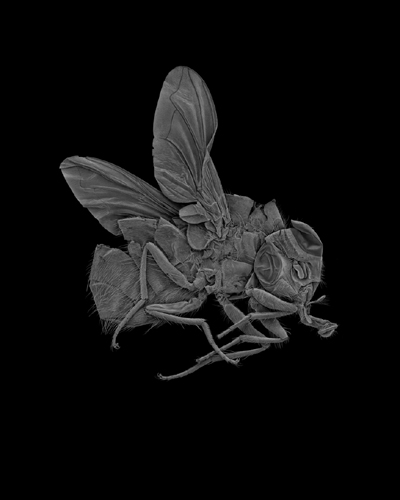
Bluebottle
Paper
183
x 146 cm
2002
© Giles Revell courtesy of Michael Hoppen Gallery, London
Freshly caught specimens of everyday or well-known insects, such as the woodlouse, ladybird, grasshopper or scarab, were used to create the works. Detail such as colour is lost in the process of coating the specimens in gold in order to photograph them under the electron microscope, and Giles was in any case interested in portraying views of the insects that might be unfamiliar. The result is that it is mainly the undersides of the insects that we see, and that interesting comparisons can be made between genera from the photographs. Two gold-coated specimens are on show within the exhibition: the model for “Pill Woodlouse” which is in fact approximately half a centimetre in diameter, and a cockroach in a position of almost perfect symmetry.
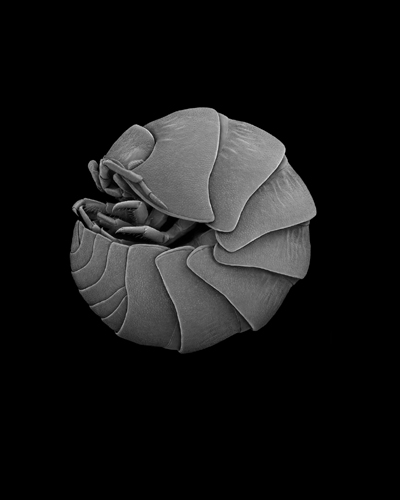
Pill Woodlouse
Paper
183
x 146 cm
1998
© Giles Revell courtesy of Michael Hoppen Gallery, London
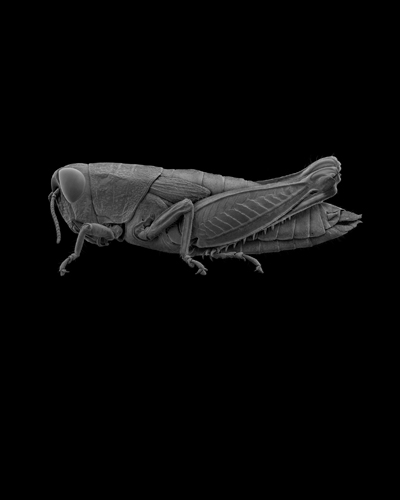
Grasshopper
Paper
183
x 146 cm
1998
© Giles Revell courtesy of Michael Hoppen Gallery, London
His other work, for which unfortunately no images are available, has a softer feel, almost like a delicate watercolour or ink drawing, and emphasizes the effectiveness of subdued, monochrome hues. One picture shows an array of bluebottles crawling up and gradually congregating towards the top of the image, whereas photographs of cast insect skins capture their transparency and an impression of an almost bronzed or metallic sheen.
Giles originally came from a background in geology, to which his fascination with sculptural form is partly due, but now works as a commercial photographer specializing in still life. He has won numerous photographic and art direction awards, and was awarded a NESTA (National Endowment for Science, Art and Technology) grant that enabled him to create several of the works featured in this exhibition.
Robert Hooke's Micrographia
Alongside Mark Fairnington and Giles Revell's work, the Natural History Museum's copy of this volume, first published in 1665, which served as an inspiration to both Isaac Newton and Antoni van Leeuwenhoek, is being publicly displayed for the first time. Hooke was credited with the first use of the single lens, with which bacteria and organisms of a similar size could be viewed; a talented draughtsman and polymath, his fine, accurate drawings, of both man-made and natural objects, provide perhaps the first insights into the world beyond the naked eye.
****************************************************************************************
Projects such as the “Fabulous Beasts” exhibition underline the importance of art in the communication and portrayal of scientific ideas; they also illustrate the high level of technical skill and capacity for keen observation on the part of the artist necessary to achieve this, and the importance of keeping these skills alive. Projects of this type encourage artists and scientists to work together, to exchange ideas and perspectives and successfully blend their respective areas of specialization. It also becomes apparent that the ways in which a scientist and a representational artist work are very similar; both are seeking to document the physical features of an organism exactly, ideally to the highest possible level of refinement and accuracy.
My special thanks go to Mark Fairnington and Giles Revell, and also to Sarah Hoyle and Becky Chetley, of the Natural History Museum Press Office.
“Fabulous Beasts” is at the Jerwood Gallery, Natural History Museum, until 12 September 2004; admission to the Museum and exhibition are free.
****************************************************************************************
Comments
to the author,
Christina Brodie are
welcomed via her website www.queen-christina.com.
Editor's note: The reviewer, Christina
Brodie has shared a selection of her own beautiful drawings of nature, including
artwork of microscopic organisms, in the Micscape articles below:
Published in the June 2004 edition of Micscape Magazine.
Please report any Web problems or offer general comments to the Micscape Editor.
Micscape is the on-line monthly
magazine of the Microscopy UK web
site at
Microscopy-UK.
© Onview.net Ltd, Microscopy-UK, and all contributors 1995 onwards. All rights reserved. Main site is at www.microscopy-uk.org.uk with full mirror at www.microscopy-uk.net.